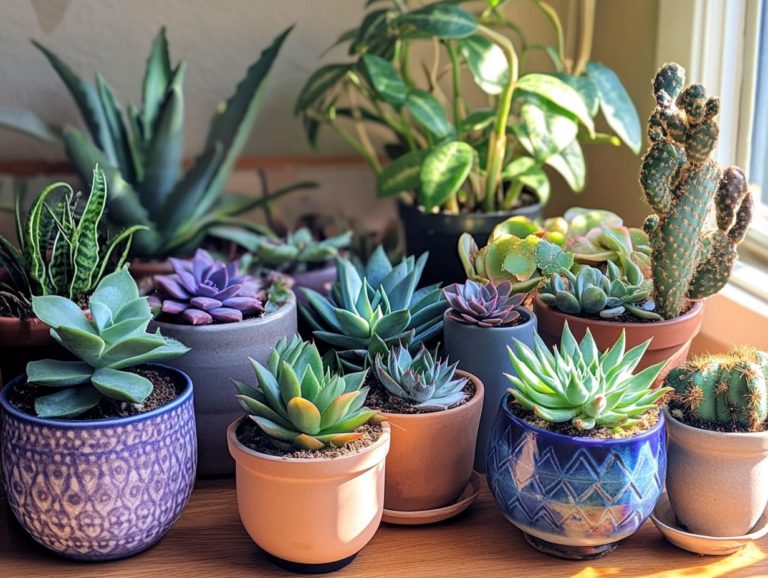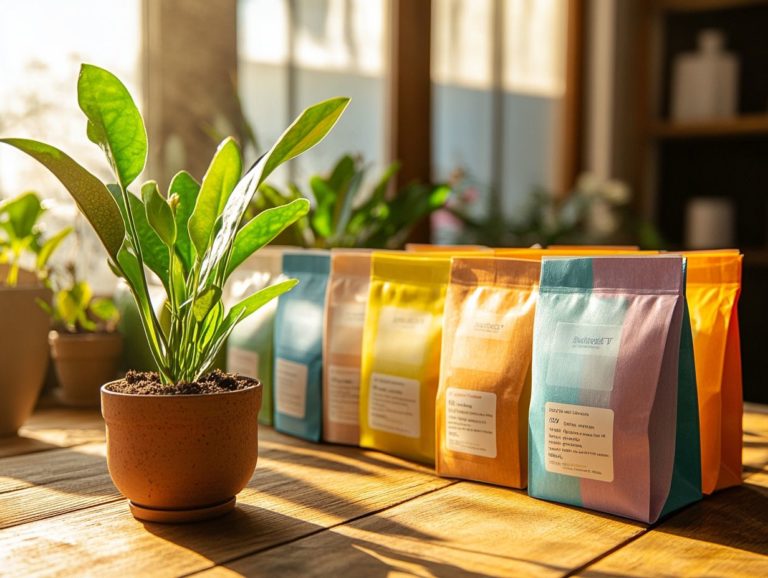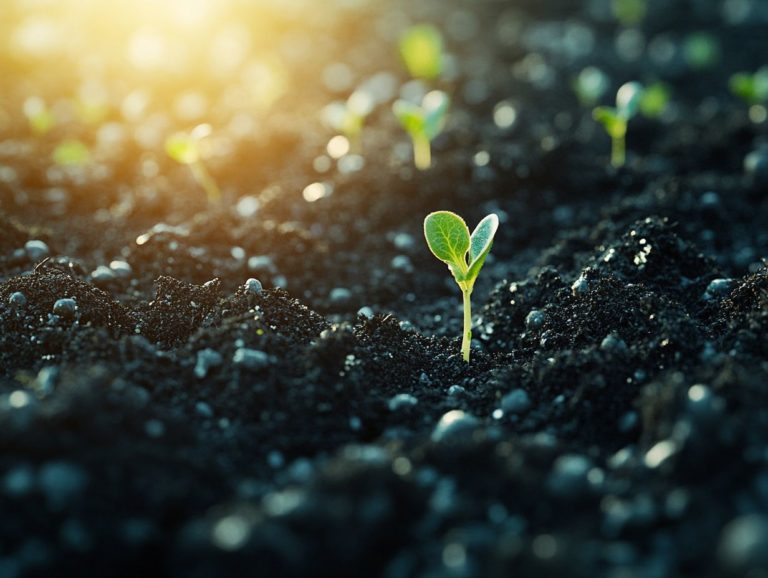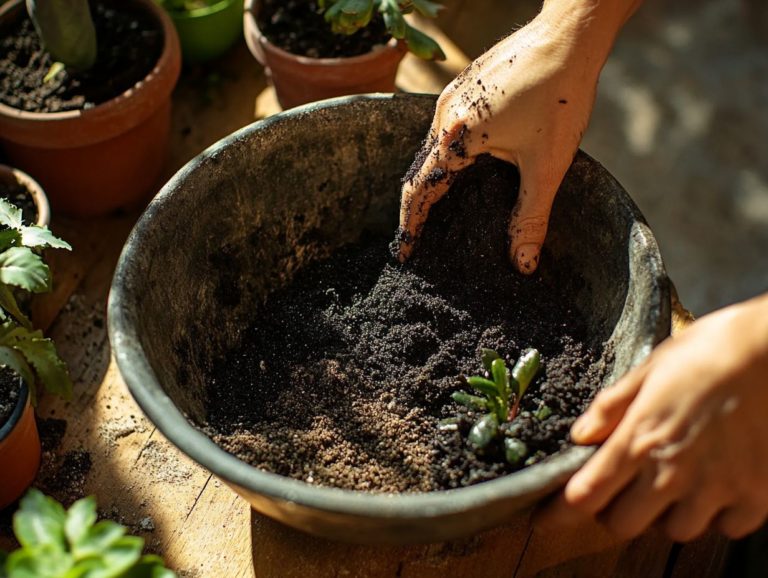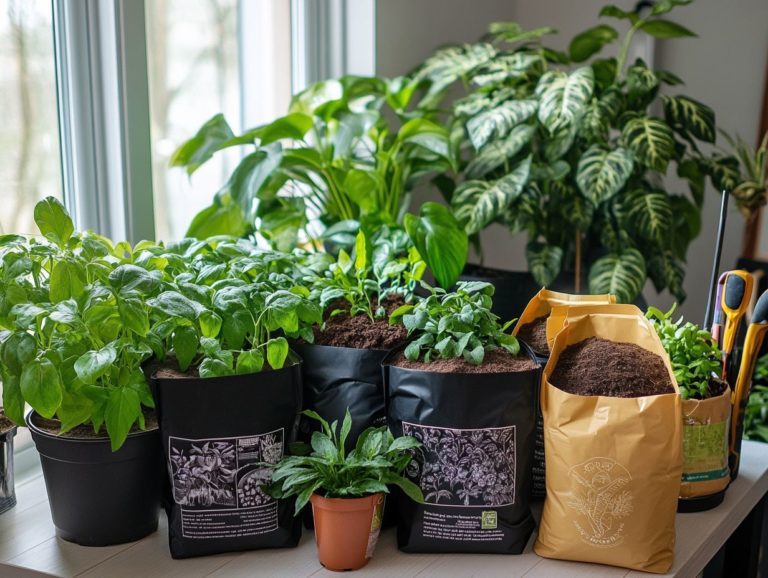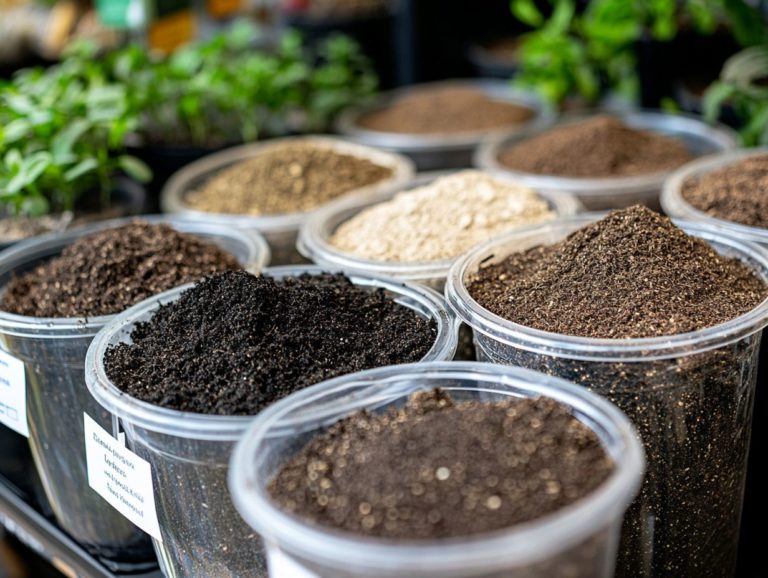How to Choose Soil for Her Indoor Garden
Ready to transform your indoor space into a green paradise? Choosing the right soil is your first step! Taking care of indoor plants and helping them grow well with the right potting soil is essential.
This article explores the basic parts of soil, highlighting key factors to consider based on your specific plant species and environmental conditions. You will also learn about the benefits associated with different soil types.
Whether you prefer organic or inorganic options, you ll find a thorough examination of the pros and cons. You will also learn how to test and prepare your soil, including tips on drainage holes to prevent root rot and keeping it healthy while avoiding common challenges like fungus gnats.
Get ready to create your own beautiful indoor garden!
Contents
- Key Takeaways:
- Understanding Soil Composition
- Factors to Consider when Choosing Soil
- Types of Soil for Indoor Gardening
- Testing and Preparing Soil for Indoor Gardening
- Maintaining Healthy Soil for Your Indoor Garden
- Frequently Asked Questions
- How do I choose the right soil for my indoor garden?
- What are some important factors to consider when choosing soil for my indoor garden?
- Can I use regular garden soil for my indoor plants?
- What is the best type of potting mix for indoor plants?
- Is it necessary to sterilize the soil before using it for my indoor garden?
- How often should I replace the soil in my indoor garden?
Key Takeaways:

- Choose soil based on plant species and growing conditions for best results.
- Consider the environmental impact of soil choices in your indoor garden.
- Regularly test and maintain soil pH and nutrient levels to keep your plants healthy.
Understanding Soil Composition
Understanding soil composition is crucial for your indoor gardening success. It directly impacts everything from nutrient availability to moisture retention, which is the ability of soil to hold water, for the diverse plant species you might choose.
The right soil mix can be the deciding factor in the health and thriving potential of your indoor plants, whether they are African violets, Monstera, or Fiddle leaf figs.
By thoughtfully selecting components like organic potting soil, coco coir, perlite, and vermiculite, you can create an optimal environment that wards off issues like root rot and encourages vibrant growth.
Plus, adding amendments such as worm castings and orchid bark can further enhance the soil structure, elevating your gardening experience to new heights.
Key Components and Their Functions
The key components of potting soil coco coir, perlite, and worm castings are essential for creating a balanced environment for your houseplants.
Coco coir is a natural material made from coconut husks and excels in moisture retention. It s perfect for tropical plants like orchids and Monstera that thrive in humid conditions. Meanwhile, perlite enhances aeration, vital for moisture-loving plants such as ferns and peace lilies. It also prevents soil compaction, a common cause of root rot.
By mixing these components in the right ratios, you can create the ideal soil blend: consider a combination of 60% coco coir, 30% perlite, and 10% worm castings. This mix strikes the perfect balance between moisture retention and drainage, supporting the healthy growth and vitality of various houseplants.
Factors to Consider when Choosing Soil
Selecting the ideal soil for your indoor gardening endeavors requires thoughtful consideration of several key factors. You ll want to consider the specific plant species you’re cultivating, the growing conditions they thrive in, and the distinct needs of moisture-loving plants compared to drought-tolerant varieties like cacti and succulents.
Making the right choice helps you avoid pitfalls like root rot and pesky fungus gnats. It also enhances nutrient availability and promotes the overall health of your plants.
Plant Species and Growing Conditions
Different plant species have distinct growing conditions that dictate the ideal soil mix for your houseplants.
Take the Monstera, for instance. Its dramatic leaves flourish in a potting mix that prioritizes aeration and drainage, ensuring its roots don t languish in water.
Meanwhile, the Fiddle Leaf Fig prefers a blend that retains moisture without becoming soggy. On the flip side, orchids require a specialized mix, typically composed of bark and sphagnum moss, to accommodate their unique root structures and allow them to breathe.
It s essential to consider if your plants are indoors or outdoors. Indoor environments often demand adjustments in soil composition to find the right balance between moisture retention and drainage. The right soil not only supports healthy growth but also plays a crucial role in preventing root rot and enhancing overall plant vitality.
By understanding how to tailor soil mixes to meet specific needs, you can significantly elevate your plants’ performance.
Environmental Impact
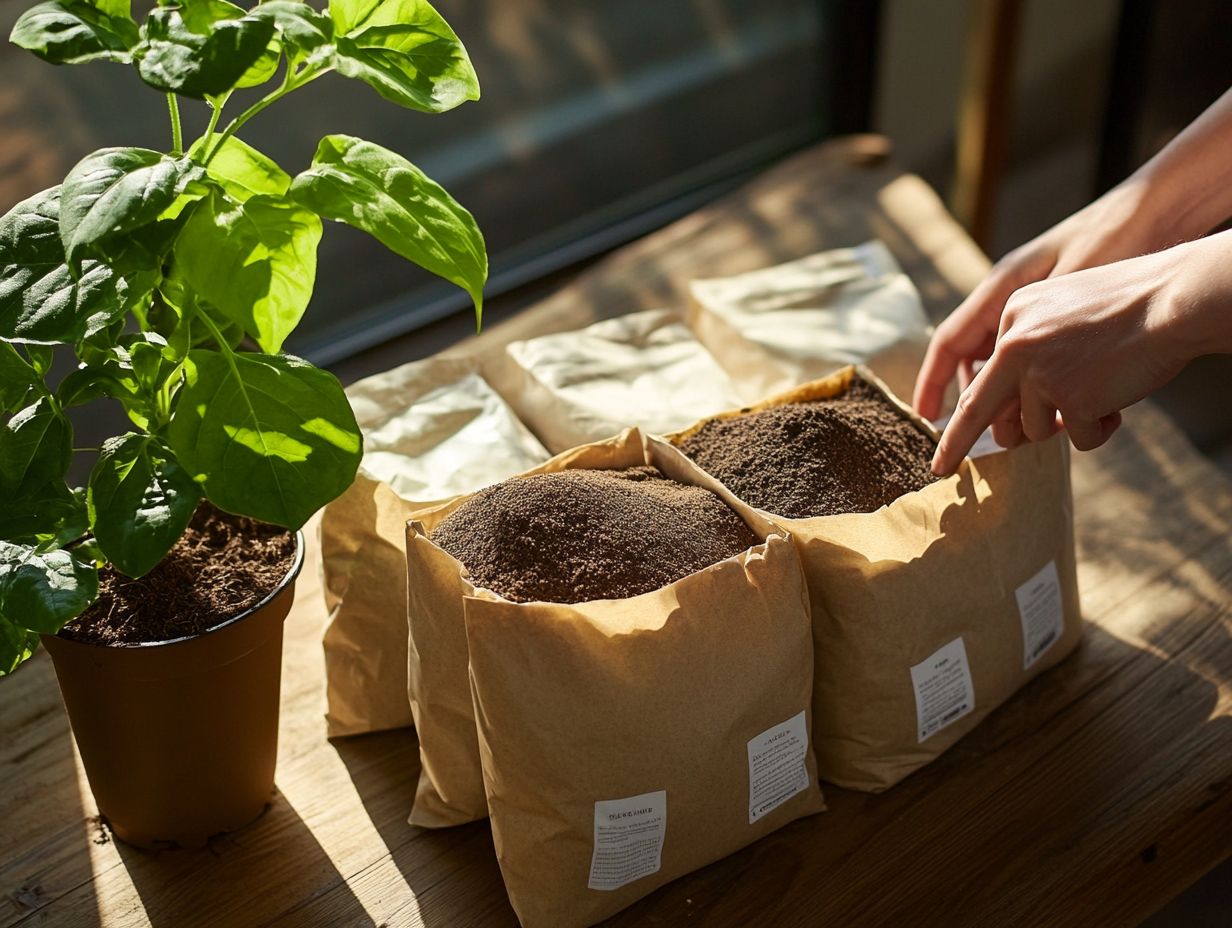
Your choice of soil has a significant environmental impact, especially when comparing synthetic fertilizers and natural options for indoor gardening.
The right fertilizer doesn’t just affect plant growth; it also influences eco-sustainability. By weighing the pros and cons of synthetic versus natural fertilizers, you can make informed choices for a vibrant garden.
Synthetic fertilizers may promise quick results, but they can cause chemical runoff and soil degradation. These issues negatively impact beneficial microorganisms.
On the other hand, natural fertilizers enhance soil structure and promote long-term fertility. They create a sustainable growing environment.
By adopting eco-friendly gardening practices, you nurture both your plants and the planet.
Types of Soil for Indoor Gardening
In indoor gardening, various soil types are available. Understanding the differences between organic and inorganic mixes is key to healthy plant growth.
Organic mixes contain natural ingredients like peat moss and worm castings, creating a rich foundation for growth. In contrast, inorganic options include perlite and vermiculite, which improve aeration and drainage.
Grasping these differences empowers you to create the ideal environment for your plants to thrive.
Organic vs. Inorganic
Organic soil consists of natural ingredients. Inorganic soil often contains synthetic additives to improve drainage and aeration.
This difference affects plant health and nutrient availability. Organic soil, rich in compost and microorganisms, supports a thriving ecosystem that makes nutrients accessible to plants.
For example, crops like tomatoes and peppers thrive in such environments, showing vigorous growth and excellent flavor.
Inorganic soil provides rapid nutrient release, which can benefit short-term crops like corn. However, over-reliance on synthetic materials can lead to soil degradation and pollution.
Understanding these dynamics is crucial for anyone aiming to optimize yields while maintaining ecological balance.
Pros and Cons of Each Type
Each soil type has its own advantages and disadvantages, affecting nutrient availability and overall plant growth.
Organic potting soil is valuable for its rich diversity of beneficial microorganisms, enhancing soil health and promoting vibrant plants. It retains moisture well, leading to healthier root systems and less frequent watering.
However, organic soil may come with a higher price tag and may not provide precise nutrient content, potentially causing imbalances for some plants.
Synthetic soil options offer controlled nutrient composition, allowing for tailored plant care. Yet, they often lack natural advantages, requiring more frequent amendments for plant health.
Understanding these nuances can elevate your indoor gardening practices significantly.
Testing and Preparing Soil for Indoor Gardening
Testing and preparing soil is essential for creating the ideal growth environment for your plants. This process involves checking pH levels and nutrient content to customize your soil mix for different houseplants.
How to Test for pH and Nutrient Levels

Testing pH and nutrient levels is a breeze with home testing kits, providing invaluable insights into your soil’s composition. These kits are designed for ease of use, making them perfect for homeowners and amateur gardeners alike. By following a straightforward procedure, you can gather critical information to help optimize your garden’s health.
Begin by collecting soil samples from various areas of your garden to ensure a well-rounded mix. Then, follow the instructions that come with the kit to test for pH, nitrogen, phosphorus, and potassium levels.
For example, optimal pH ranges vary among plants. Blueberries flourish in acidic soils (pH 4.5-5.5), while most vegetables prefer a slightly alkaline range (pH 6.0-7.0). By understanding these parameters, you ll be well-equipped to enhance growth and yield in your garden.
Improving and Conditioning Soil for Optimal Growth
Improving and conditioning your soil is essential for creating a nutrient-rich environment that supports the optimal growth of your indoor plants.
Incorporating popular amendments like worm castings and orchid bark can significantly improve soil texture and moisture retention capabilities. Worm castings are rich in nutrients and beneficial microorganisms, making them an outstanding choice for enhancing soil health. Meanwhile, orchid bark enhances aeration, preventing compaction and ensuring that roots have the breathing room they need.
To mix these amendments, combine a handful of worm castings with a portion of orchid bark alongside your existing soil, ensuring an even distribution. Timing is key; consider doing this in early spring or right after repotting to give your plants a fresh start. Repeat this process every six months to maintain your soil’s vitality.
Maintaining Healthy Soil for Your Indoor Garden
Make soil health your top priority for a thriving indoor garden. This involves employing precise watering and fertilization techniques tailored to the specific needs of your plants.
By doing so, you’ll create an optimal environment that nurtures growth and vitality.
Proper Watering and Fertilization Techniques
Proper watering and fertilization techniques are essential for maintaining healthy plants and preventing issues like root rot.
Understanding the specific needs of different plant varieties is crucial. For instance, tropical plants flourish in consistently moist soil, necessitating a frequent watering schedule. In contrast, succulents thrive in drier conditions and require much less water. This differentiation in care affects their overall health and influences their growth patterns.
Regarding nourishment, you should also consider whether to use synthetic or natural fertilizers based on your plants’ requirements. Natural options can foster a more balanced ecosystem, whereas synthetic fertilizers may offer quicker results. By evaluating the types of plants in your collection, you can determine the best approach for achieving optimal growth.
Preventing and Treating Soil-Borne Diseases
Act now to reduce risks associated with soil-borne diseases, essential for maintaining the vitality of your indoor garden. Issues like root rot and fungus gnats can lurk in the shadows.
To effectively reduce these risks, prioritize proper drainage. Ensuring that excess water doesn t pool at the bottom of your pots can be a game-changer in the battle against root diseases. Consider incorporating soil sterilization techniques, like microwave heating or steam, to eliminate harmful pathogens that might be hiding in the soil, just waiting for the right moment to strike.
When addressing existing issues, applying organic fungicides and routinely inspecting your plants can significantly boost their resilience. Embracing disease control strategies enhances plant health and nurtures a thriving indoor ecosystem, transforming your gardening experience into something truly rewarding.
Frequently Asked Questions
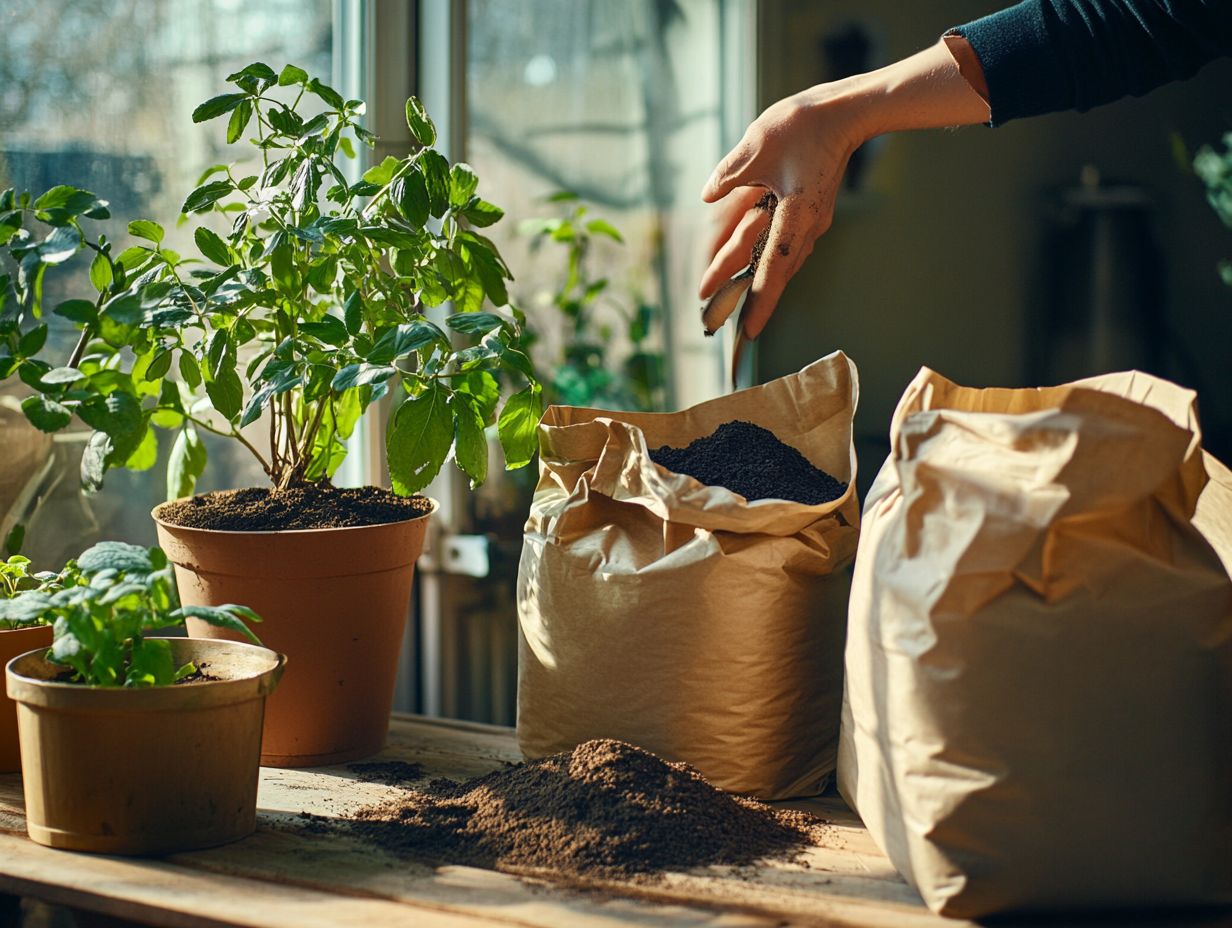
How do I choose the right soil for my indoor garden?
Choosing the right soil is crucial for your indoor garden’s health. Consider the type of plants you will grow and their specific soil needs.
You can also opt for pre-made potting mixes specifically formulated for indoor plants.
What are some important factors to consider when choosing soil for my indoor garden?
Texture, drainage, and nutrients are key factors to consider. Indoor plants typically do well in light, well-draining soil rich in organic matter.
Don’t forget to check the soil’s pH level, as different plants thrive in various acidity levels.
Can I use regular garden soil for my indoor plants?
It’s not recommended to use regular garden soil for indoor plants. Garden soil is often too heavy and dense for pots, which can lead to poor drainage and root rot.
Additionally, it may contain pests and diseases that can harm your indoor plants.
What is the best type of potting mix for indoor plants?
Many types of potting mixes are available, but the best one for your indoor plants depends on their specific needs. A mix of peat moss, perlite, and vermiculite works well for most indoor plants.
You can also add compost or fertilizer for extra nutrients.
Is it necessary to sterilize the soil before using it for my indoor garden?
Sterilizing soil isn’t always necessary, but it helps prevent the spread of diseases and pests. If you’re reusing soil, definitely sterilize it to keep your plants safe and healthy!
You can sterilize soil by heating it in the oven or microwave or by using a commercial sterilizing product.
How often should I replace the soil in my indoor garden?
Make sure to refresh your indoor garden’s soil every 1-2 years for thriving plants! Over time, soil can become compacted and depleted of nutrients.
You can also top-dress the soil with compost or fertilizer to refresh it without completely replacing it.

